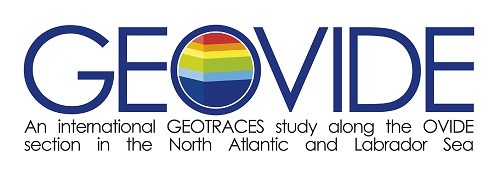Persons in charge: Hélène Planquette (LEMAR) / François Lacan (LEGOS)
Participants: F. Planchon, G. Sarthou, C. de la Rocha, ANR research associate, PhD student (LEMAR), F. Lacan, C. Jeandel, P. van Beek, C. Pradoux, V. Bouvier, M. Souhaut (LEGOS).
For most TEIs, particulate data are extremely scarce in the Global Ocean (much scarcer than dissolved ones). The strong particulate component of the GEOVIDE project will allow partially filling this gap. This is of major importance for our understanding of TEI cycles in the ocean. TEI sinks are associated with the settling of particles to the sediments. Particles settling velocities can be derived from 230Th data. Combined to particle TEI concentrations, these data will allow the quantification of TEI fluxes to the sediments, in various environments. From such estimations, TEI residence times will be estimated concomitantly. For many TEIs, the particulate sources are orders of magnitudes larger than the dissolved sources (Oelkers et al., 2011). Characterizing this phase close to the interfaces is therefore of first importance. Advective sources of particles will also be estimated notably from the data of the other recent GEOTRACES cruises in the North Atlantic. The importance of characterizing both the dissolved and the particulate phases in the ocean, for the sources and sinks, is very well illustrated when one wants to model the TEI oceanic cycles. One of the first data a modeler will need is the partition coefficient (Kd) representing the fraction of the tracer in each phase. Such values are extremely scarce. GEOVIDE will provide such data, notably by combining statistical methods (as that used in Chase et al. 2003) and direct particle characterization (SEM, XRD, XPS). Moreover, direct measurements of the mass of particle per mass of seawater being almost impossible, we will compute what we call « composite particle masses ». A particle is supposed to be the sum of calcite, opal, POC, alumino-silicate, iron and manganese oxides. Each phase is estimated from one of its major component (e.g. Ca for calcite) and the particle mass is calculated as the sum of those phases.
Samples will be taken from the in-situ pumps (Th, Pa, Nd, and isotopes, and REEs), from Niskin-CTD rosette (Si isotopes), and from Go-Flo clean rosette (total dissolvable Fe, particulate trace metals, and Fe isotopes). Aerosol samples will be collected using a high-volume (1 m3 min-1) sampler (Graseby-Anderson).
This task is strongly linked to the ANR-PDOC BITMAP (coordinated by H. Planquette), which aims to investigate the distribution and potential bioavailability of particulate trace elements in different size-fractions, and more particularly the task 2 of the BITMAP project : “Characterization of spatial distribution of particulate trace metal among different size-fractions in the North Atlantic”. Parameters that are included and funded by ANR-PDOC BITMAP are size-fractionation of particulate trace metals (0.45-5µm, 5-21 µm, > 21 µm). Several members of the GEOVIDE consortium participated to previous GEOTRACES cruises, including intercalibration cruises and have all the necessary skills to complete successful clean sampling and analyses of the particulate phase. Although they would provide very useful particulate samples, sediment traps are not planned in GEOVIDE, because they would require too much ship time and logistics.
